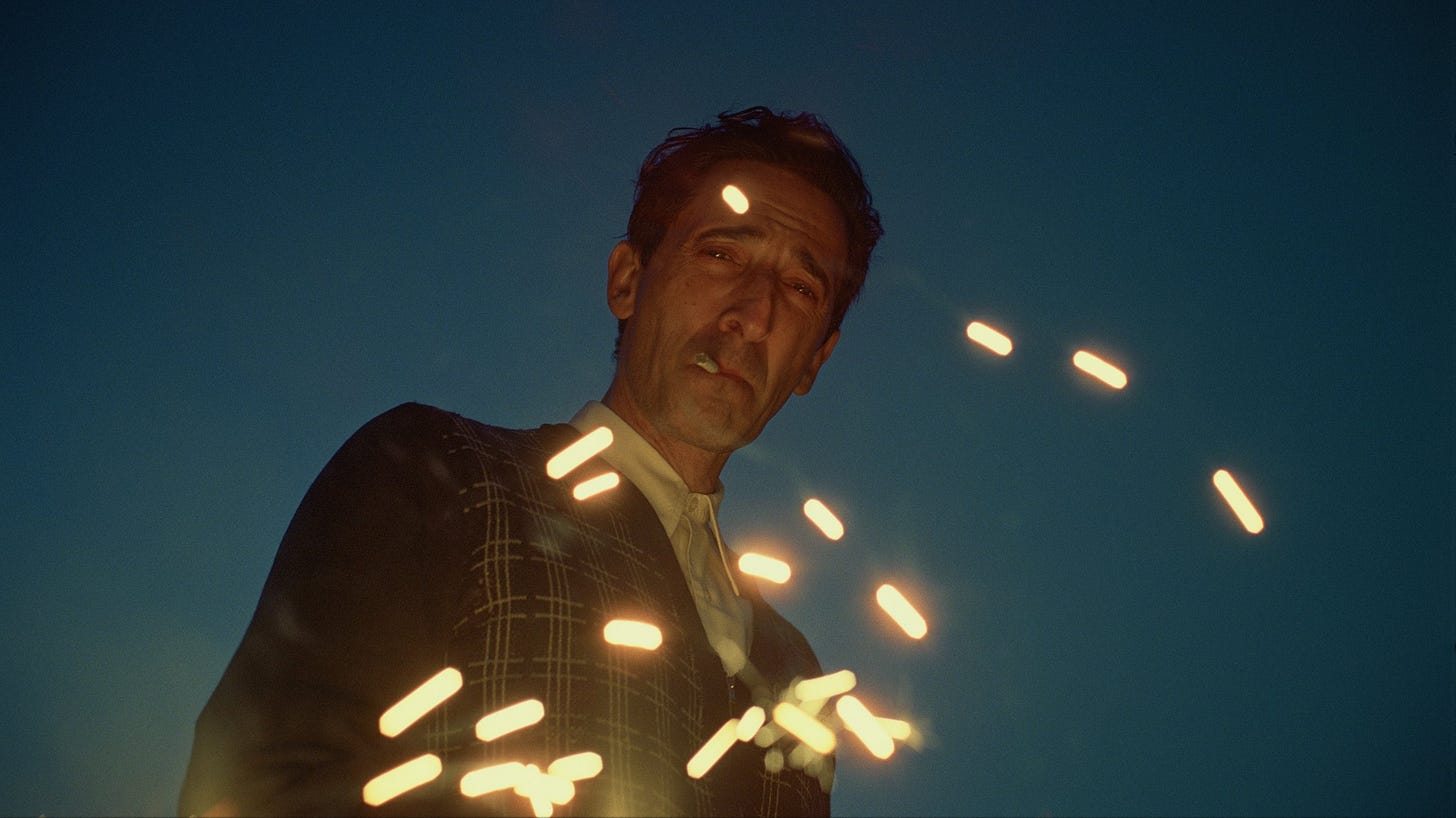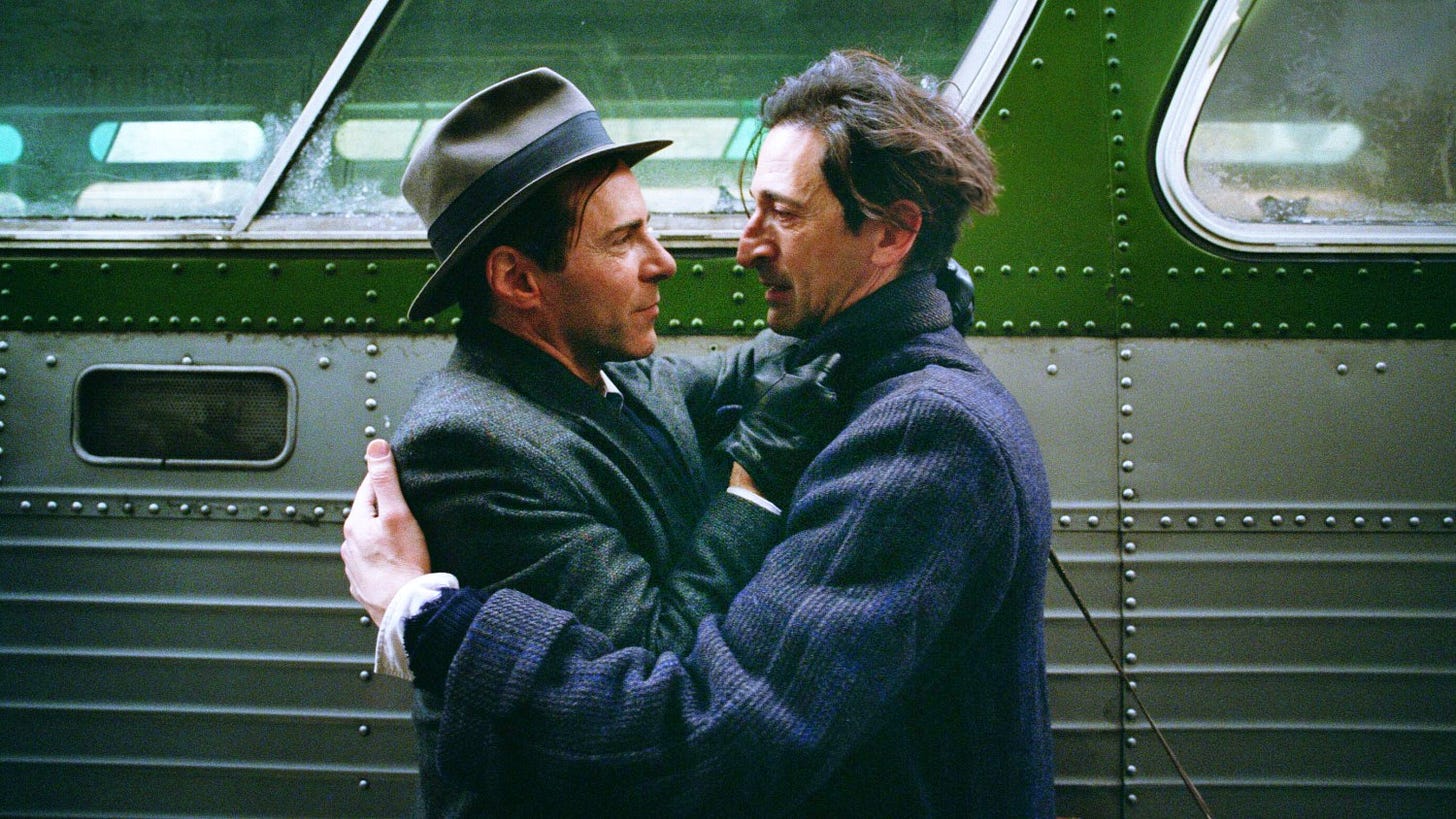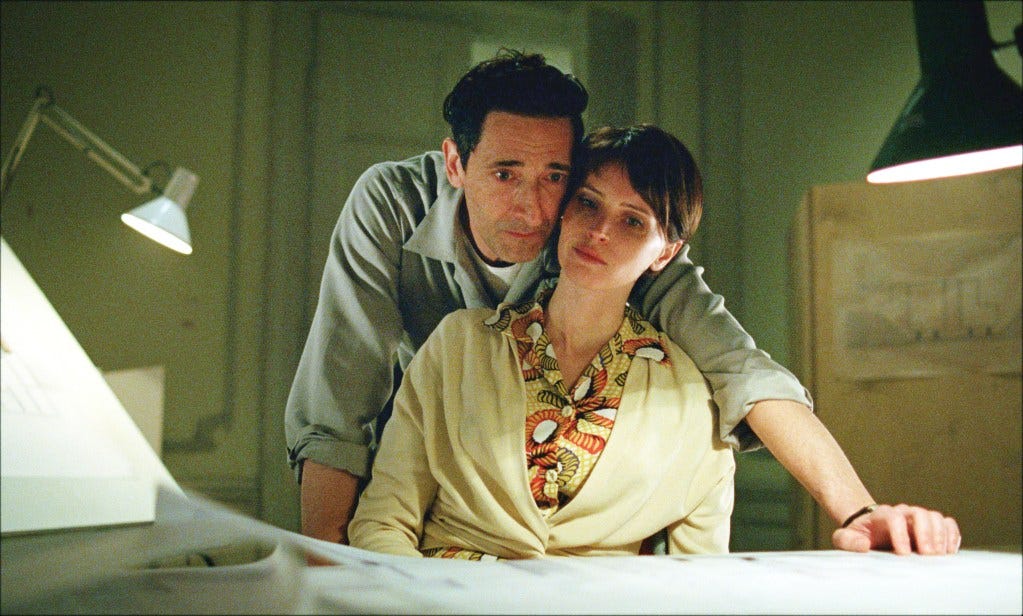The Brutalist (2024)
Director Brady Corbet gives Adrien Brody the role of a lifetime in post-WWII America
The Brutalist (2024)
In theaters
This is moviemaking in a dimension — I mean roaming the labyrinthine inner lives of relentless, fanatical men — not often fully realized in American movies.
Our movies’ crazy “geniuses” (Megalopolis) and men of hard metal or mettle (the Marvel world; Tom Cruise; the Rock) aren’t actually risking much. We know they’ll end up claiming victory. The movies they storm through leave us in no doubt. To know them is to gaze up at them.
The 36-year-old director Brady Corbet and his co-screenwriter Mona Fastvold think boldly and write fearlessly about an altogether different breed: dangerous men who just want, ceaselessly, unbound by reason, driven by dark “ideals” and unbridled lust for triumph.
To know them is to buckle under to them or to get out of their way. There’s ample reason this movie’s runtime of 3 hours and 35 minutes is paused with a 15-minute intermission. You’ll spend the interval shaking your head in shock and astonishment.
The movie is an intensely American expose, throwing “the American Dream” into stinging doubt. In 1947, Hungarian Jewish architect László Toth (Adrien Brody) arrives at New York’s Ellis Island a broken, bare survivor of the Holocaust.
Before WWII he’d practiced in the Bauhaus architectural tradition. This gave him a distinguished career designing buildings across Europe in the Brutalist style, marked by minimal ornamentation, bold slabs of concrete and narrow, sharply angled sources of light.
Oddly, this fierce unrelenting aesthetic could be said to resemble the war-ravaged László’s state of mind.
His sense of self has been shattered by wartime hatreds and divisions. And in Europe’s postwar bureaucratic confusion he’s had to leave his wife and niece behind in Budapest, mired in red tape.
It’s only because he was vouched for by an American cousin that he was able to gain entry to the U.S. with the fragile prospect of finding work as an architect.
With his professional opportunities in Europe eclipsed by political strife and a virulent lingering antisemitism, he hasn’t been able to revive his career in Hungary. America is his only hope, and when he’s greeted in Philadelphia by his cousin Attila (Alessandro Nivola), he weeps, trembles and all but collapses in relief.
In America: a grateful László (Adrien Brody) meets his cousin Attila (Alessandro Nivola)
Attila has built a modest furniture business which can make good use of László’s keen eye for design. Soon they land a promising contract to redesign the library of wealthy businessman Harrison Van Buren (Guy Pearce).
But once they finish the work Harrison is revolted by the library’s spartan, starkly modernist design, and, refusing to pay for it, furiously throws Attila and László out.
Let’s step back, the script shrewdly suggests. In America, art and commerce can dance around one another, testing which one will give way.
When the library’s design is discovered by the art world and photographed in national magazines, Harrison recants and apologizes for his tantrum, realizing László is indeed a gifted artist. He makes him an offer.
Harrison contracts László to design and build a monumental community center in Doylestown, Pennsylvania to honor his late mother.
But the desperate architect doesn’t fully realize that the industrialist is scheming to harness László’s gift, not to help emancipate it. The community center is a vanity project to heighten Harrison’s own standing; László is simply a means to that end.
Corbet is a director working on the raw emotional edges, not offering his characters or his audience much in the way of mercy. And he lays out this cautionary vision without emulating or working in the mold of any predecessor that I can point to. He’s wholly inner-focused, driven, heedless.
At wit’s end, the artist seizes the challenge, and Harrison sweetens the deal by getting his lawyer to fast-track the refugee’s wife and niece’s immigration.
When his wife Erzsébet (Felicity Jones) and niece Zsófia (Raffey Cassidy) arrive, he believes he can both refashion his professional reputation and rebuild his marriage.
But while Harrison claims to “admire” László he insists on keeping him in his place, servant to master. Erzsébet quickly gets wise to this rich egotist and refuses to see her gifted husband truckle to a crass millionaire who thinks his wealth entitles him to push everyone around.
In other words, patrons will patronize. Stay wary of them, she warns her husband. The contradiction of the artist at the mercy of capitalist whims eats at László’s dignity.
László and protective wife Erzsébet (Felicity Jones) assess their American dreams
On a trip to an Italian quarry to select marble for the grand project, Harrison’s shocking act of violence makes clear who he believes the dominant partner in the arrangement is and was always bound to be.
Yet László hews fast to his artistic integrity, even while admitting it’s subject to compromise, exploitation and diminishment at the will of the mighty.
Bracingly, Corbet and Fastvold end his trial by ordeal not with a roar but with the soft, persistent murmur of excellence bruised yet exultant.
But at what a price. László’s anguish courses through Brody’s body like bolts of lightning. This is an alarmingly physical performance. The refugee is crabbed and hunched up, barely able to lift his shoulders, for most of the movie. For all this gifted architect’s talent, he’s at the mercy of moneymen and has no real independence.
At low points in the past, he’s fallen into heroin use, and he resumes the wasting addiction under this latest pressure.
In his fervor to keep control of the architectural project that could save his reputation, he loses his temper when Harrison overrules him and favors the advice of hack, visionless “engineers”. László storms off, all but abandoning the effort. Does America cut aliens down to size, making a lie of its promise to lift them up?
Erzsébet is wheelchair bound due to osteoporosis. She can only help so much. Her pain becomes so agonizing that when she runs out of medication László injects her with heroin, hoping to ease her torment, while actually intensifying her despair.
Wracked with misery, his fate not in his hands, László clings to a wisp of hope. As the project nears completion can Harrison become a man of reason, abide by the decisions of an artist practicing his art?
László desperately trying to control the massive project that could turn his life around
Capitalists hate compromise, Corbet clearly believes. His script argues that it takes an act of iron will to make them bend, and the confrontation that turns the tables here comes in a jolting climax from an unexpected source.
Corbet the director makes an astonishingly apt creative choice to situate his story in industrially mighty Pennsylvania rather than László’s point of entry, New York.
Wall Street registers no threat from artists, who for all their talent can be safely compartmentalized. As Oscar Wilde once put the equation: When bankers get together in the evening, they talk about art. When artists get together in the evening, they talk about money.
But unlike Manhattan’s corridors of investment banking, in America’s industrial heartland in the 1920s through the 1970s, Pennsylvania’s coal, steel and rail dynasties comprised an unassailable material economic powerhouse. Art was another piece of property to lay your hands on.
Wealth heaped up in commerce configured everything, drew all the vital class distinctions. To see how, one might turn to John O’Hara’s novels and short stories. His writing depicts in granular societal detail how coolly and decisively Pennsylvania’s power elite maintained social control.
Harrison fits this pattern perfectly, and Pearce nails the industrialist’s arrogance, ignorance and nastiness. The actor’s depiction of a savagely stupid millionaire makes an infuriating contrast to Brody’s rabid, far from saintly yet truly inspired artist.
These two were never going to meld. Giving quarter is in neither man’s playbook. Fittingly, both actors clash and parry with stubborn fury.
They have a profoundly supportive collaborator in Corbet. He shows a moral and physical landscape that’s all but swallowing them up. Something like Theodore Dreiser’s fatalism in novels like The Financier and An American Tragedy stalks these fraught men.
From an immense overhead shot of a catastrophic train wreck to the massive interior of an Italian cave enriched with giant slabs of marble, the director and his cinematographer Lol Crawley shoot in hypnotic wide shots. Then they suddenly shift angles, so you feel you might tumble into them.
And people don’t outfox Corbet. He leans into intense close-ups of characters in rapture or peril with a cool brio. Yet he can also deftly set principles and societal forces at odds aiming his camera in glistening attack. Art and power battle, sorrow and pity gasp for air. No one gets an easy out.
This is a director working on the raw emotional edges, not offering his characters or his audience much in the way of mercy. And he lays out this cautionary vision without emulating or working in the mold of any predecessor that I can point to. He’s wholly inner-focused, driven, heedless.
Get your bets down now. This is Corbet’s third feature. He’s endowed with a master’s glee and a prodigy’s gumption. I think he’s made the Movie of the Year. Even more propitiously, I believe he’s just getting started.







